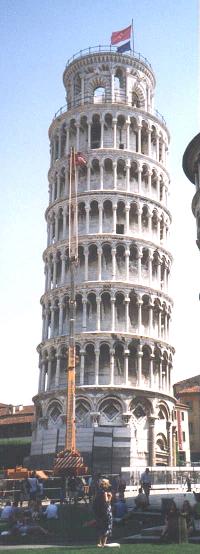The Leaning Tower of Pisa


Fig. 6-6: Lead blocks used to reduce the uneven stress distribution on foundation
The tilt of one of the world's most famous towers, the Leaning Tower of Pisa, developed because of uneven stress distribution on the soil supporting the upper structure. The eight-storey tower weights 14,500 metric tonnes and its masonry foundations are 19.6m in diameter. If the stress were uniformly distributed, this would lead to an average stress of ![]() using Eq. 6-2. As the underlying ground consists of about 10m variabke soft silty deposits (Layer A) and then 40 m very soft and sensitive marine clays (Layer B), the Tower shows that the surface of Layer B is dish-shaped due to the weight of the Tower above it [6.3]. Thus the uneven stresses on the soft soil under the Tower caused the foundation to settle unevenly, making the Tower lean.
using Eq. 6-2. As the underlying ground consists of about 10m variabke soft silty deposits (Layer A) and then 40 m very soft and sensitive marine clays (Layer B), the Tower shows that the surface of Layer B is dish-shaped due to the weight of the Tower above it [6.3]. Thus the uneven stresses on the soft soil under the Tower caused the foundation to settle unevenly, making the Tower lean.
To redress the problem many large blocks of lead were placed on the ground on the side of the Tower where the settlement was least, as shown in Fig. 6-6. The new stress in the ground caused the firmer soil on this side of the tower to compress in turn preventing further leaning of the Tower and returning the Tower back towards the vertical.
